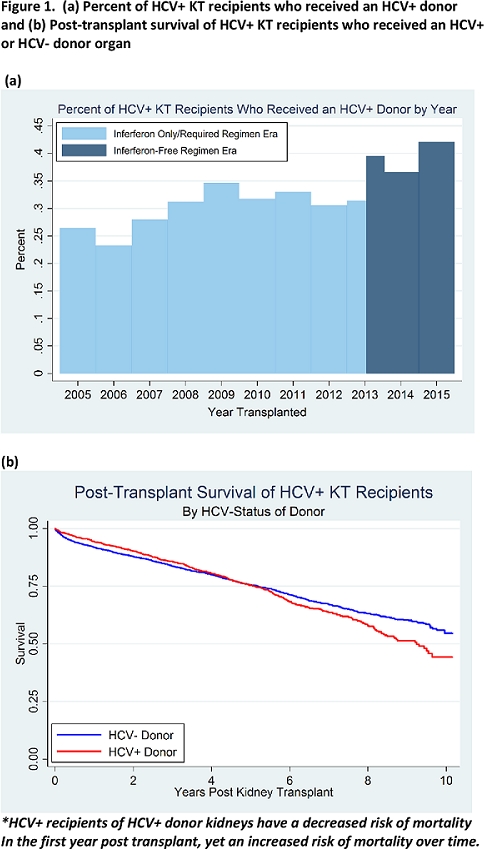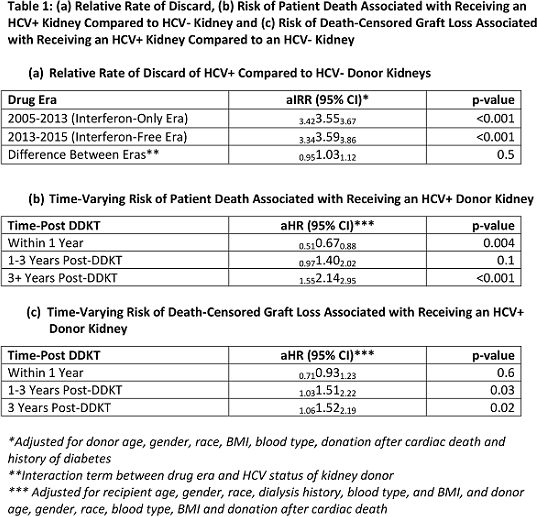Utilization and Post-Transplant Outcomes Associated with Hepatitis C+ Donor Kidneys in the Advent of Direct-Acting Antivirals.
JHU, Baltimore.
Meeting: 2016 American Transplant Congress
Abstract number: 217
Keywords: Hepatitis C, Kidney transplantation
Session Information
Session Name: Concurrent Session: Kidney Transplantation: Allocation, Discard, and HCV
Session Type: Concurrent Session
Date: Monday, June 13, 2016
Session Time: 2:30pm-4:00pm
 Presentation Time: 3:18pm-3:30pm
Presentation Time: 3:18pm-3:30pm
Location: Veterans Auditorium
The introduction of interferon-free direct-acting antivirals(DAAs) in December 2013 dramatically improved outcomes for individuals with Hepatitis C. The impacts of these therapies on utilization and outcomes associated with HCV+ deceased-donor (DD) kidneys for HCV+ recipients have not been previously characterized.
METHODS: Using 2005-2015 SRTR data, we studied 6,904 HCV+ adult KT recipients, using modified Poisson regression to estimate the relative rate(RR) of receiving an HCV+ DDKT, and Cox regression to estimate post-transplant patient and graft survival associated with receiving a HCV+ DDKT, adjusting for recipient and donor characteristics.
RESULTS: The proportion of HCV+ recipients who received a HCV+ DDKT increased from 31% in early 2013 to 42% in 2015. HCV+ recipients were 30% more likely to receive a HCV+ kidney after December 2013[aRR 1.181.301.44, p<0.001]. This increase in utilization was in excess of any existing trends prior to December 2013(p-interaction=0.007). HCV+ kidneys were discarded at 3.6 times the rate of HCV- kidneys (52% versus 16%) before and after Dec. 2013[aRR 3.343.593.86,p<0.001, p-interaction=0.5]. Risk of patient death associated with receiving a HCV+ versus HCV- DDKT varied with time, with 33% reduced risk in the first year[aHR0.510.670.88,p=0.004] and two-fold higher risk 3 years post-DDKT[aHR1.552.142.95,p<0.001].
CONCLUSION: The utilization of HCV+ kidneys has increased since the introduction of highly effective HCV therapies. HCV+ kidneys continue to be discarded at almost four times the rate of comparable HCV- kidneys. Risk of death is lower among recipients of HCV+ versus HCV- kidneys within the first year, yet risk increases over time. Changes in post-transplant outcomes under DAAs remain unknown, as we are limited by data in the recent drug era.


CITATION INFORMATION: Bowring M, Kucirka L, Massie A, Luo X, Sulkowski M, Segev D, Durand C. Utilization and Post-Transplant Outcomes Associated with Hepatitis C+ Donor Kidneys in the Advent of Direct-Acting Antivirals. Am J Transplant. 2016;16 (suppl 3).
To cite this abstract in AMA style:
Bowring M, Kucirka L, Massie A, Luo X, Sulkowski M, Segev D, Durand C. Utilization and Post-Transplant Outcomes Associated with Hepatitis C+ Donor Kidneys in the Advent of Direct-Acting Antivirals. [abstract]. Am J Transplant. 2016; 16 (suppl 3). https://atcmeetingabstracts.com/abstract/utilization-and-post-transplant-outcomes-associated-with-hepatitis-c-donor-kidneys-in-the-advent-of-direct-acting-antivirals/. Accessed December 13, 2025.« Back to 2016 American Transplant Congress
